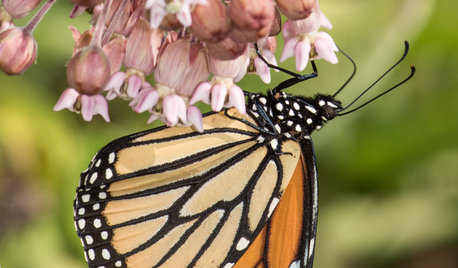Which of these two pluots will cross pollinate each other?
brownmola
11 years ago
Featured Answer
Sort by:Oldest
Comments (9)
Steve357
11 years agoSteve357
11 years agoRelated Discussions
Will Bing and Utah Giant Cherries Pollinate each other
Comments (18)ca_cherry_grower: No I did not start the non-pareil almond from a seed. It's from Costco (I believe Coiner Nursery) and was a bareroot purchase. It appeared to be a branch cutting that was rooted. Unfortunately the tips on all the terminal branches on the almond seem to be dying back and I am not sure whether it will survive. It's been 3 weeks that it's been planted (7+ hours direct sun) but not sign of any buds opening. No leaves. Nothing. They only had the non-pareil at that time. I wanted to buy another almond, but since this one is having a tough time, I am not sure about getting another. Actually I am having bad experience with 5 out of 7 bareroot plants from Costco. Above stated almond may not make it. And I had bought 4 barerroot roses from them (By Jackson Perkins) and all 4 of them developed canker. 2 of them actually had fungal infections on the roots when I opened the root wraps. I just washed the roots and treated them with fungicide hoping for the best. And all of this after picking the plants up relatively early in the season from Costco, soaking the roots overnight in room temperature water, planting them per instructions and regular irrigation (not timed, but need based - am checking the soil every single time before watering). I already spoke with Jackson and Perkins on the roses and they asked me to take them back to Costco. I spoke with Costco and they said I can bring them back anytime within a year. I want to give the roses some more time and see what happens (I hate returning stuff to Costco - given their low prices and everything!). The infected branches on the roses have been pruned but it might still be a problem coz. the main stems are infected too. I am currently treating them systemically and had even sprayed them before beginning the systemic treatment. If they do show some growth, at least enough to give me a branch or two at the end of season for rooting, I might keep them - even if it will set me back by a year or 2. Two are patented, so I will need permissions from the hybridizer - which I am not sure how easy it will be. Let's see. I have a visit planned on the 6th to a nursery in Fremont, CA (Regan's Nursery). I might pick up some more roses from there and if they have the almods and lime - then I might pick those up too. I will give the current almond tree I have until then. Edlo - Thanks for the tip on pruning. I will look it up on google....See MoreWill HoneyCrisp and Spitzenburg apples pollinate each other
Comments (9)Last Earth: Do not confuse bloom period with ripening order. There is no direct relationship. Bloom period is the one that is important to pollination. In my experience, with over 30 apple varieties, it is hard to say which ones cross-pollinate, since they all seem to be in bloom at about the same time. I wouldn't expect it to be a problem if you have three trees. But Murky's point about triploid varieties like Gravenstein is an important one. I have several triploids out there (Stayman, Spigold, Mutsu etc.), which are pollen sterile and cannot pollinate anything. But there are other apples that can pollinate them, and there are a pretty fair number of decorative crabs in the neighborhood, which are excellent pollinators. Apples are pollinated by insects, which fly several hundred yards or more between trees. If anything, overset is more common on apples than underset, requiring the orchardist to do some thinning on the clusters. I thin to one per cluster, but two is about the maximum if you want apples of decent size and quality. Don Yellman, Great Falls, VA...See MoreWill Korean Giant and Shinko cross pollinate each other?
Comments (2)Jessica, according to the Raintree site (see link below) the KG doesn't pollinate many things, but I think its because its an earlier bloom so it may in fact work OK most years. Re: Shinko, that pear for me is bitter and not very sweet so I am going to chop mine down if it doesn't get any better. Apparently other people do get good fruits off of it, just not me. I would instead recommend a Yoinashi which is an excellent pear (and, it will also be pollen compatible with KG according to Raintree). Yoinashi is about like KG in terms of fireblight resistance; Shinko is the most resistant. Bareroot trees tend to be cheaper and also cheaper shipping so I nearly always go that route. In a few weeks the potted ones start to be preferred because it will be getting too late for bareroot planting. Potted can be transplanted year-round. Scott Here is a link that might be useful: Asian pear pollination chart...See MoreWill pembina and toka plum pollinate each other?
Comments (24)Matt - I did ind out a few more things but it just seems to make it ore complicated. It turns out that toka is a hybrid between P simonii. P simonii is considered " an upright variation of P salicina. On top of that all large japanese plums used in california (most of the ones used for the hybrids) are actually crossed with simonii anyways. The difference I found (and im still not 100% clear on it) is that toka is more or less a P simonii/salicina x american plum, which as you noted seems to make pollination way less clear. The main problem with P simonii is "a severe lack of pollen" which would explain why the hybrids have a hard time pollinating eachother. From the little that I can understand it seems that the hybrids arent incompatible, its just little pollen to pollinate with. I guess Toka may have more pollen which is why its recommended as a pollinator. Plum - the U of sask article states grafting the P nigra scion low so that it will help initiate proper flowering. Charlie - that is pretty much what I have seen as well. Pretty much the reason why I posted. It does seem to go a lot deeper then that when it comes to toka. All those california plums are apparently salicina x simonii, and simonii is said to just be an upright form of salicina........See Morebrownmola
11 years agoSteve357
11 years agofruitnut Z7 4500ft SW TX
11 years agobrownmola
11 years agoKevin Reilly
11 years agobrownmola
11 years ago
Related Stories

GARDENING GUIDESMeet the Grass-Carrying Wasp, a Gentle Pollinator of Summer Flowers
These fascinating insects nest in wood cavities and hollow plant stems
Full Story
NATIVE PLANTSPlant These Fall-Flowering Natives in Early Summer for Pollinator Love
These 3 groups of plants will support masses of beneficial insects come autumn
Full Story
FLOWERS AND PLANTSPlant Baptisia Bracteata for Blooms Pollinators Will Love
Longbract wild indigo is great in dry soil, and its spring flowers attract butterflies and bumblebees
Full Story
KITCHEN DESIGN12 Great Kitchen Styles — Which One’s for You?
Sometimes you can be surprised by the kitchen style that really calls to you. The proof is in the pictures
Full Story
DESIGN DICTIONARYCross-Hipped Roof
Better in a hurricane and strong on shade, this roof has two sections that meet in the middle
Full Story0

FLOWERS AND PLANTSHelp Monarchs and Other Butterflies by Planting Common Milkweed
Summer-blooming Asclepias syriaca is an important larval host plant for the monarch butterfly and attracts a number of pollinating insects
Full Story
KITCHEN DESIGNA Two-Tone Cabinet Scheme Gives Your Kitchen the Best of Both Worlds
Waffling between paint and stain or dark and light? Here’s how to mix and match colors and materials
Full Story
GARDENING FOR BIRDSBackyard Birds: How to Identify Two Common Woodpeckers
Downy and hairy woodpeckers have similar coloration and behavior. But there are two big differences that separate them
Full Story
KITCHEN DESIGNTwo-Cook Kitchens Have Smart Space Chops
Seven Houzz users show off their clever solutions to having two — but not too many — cooks in the kitchen
Full Story
EDIBLE GARDENSGrow Plum Hybrids for Your Favorite Fruit Flavors
Plums are cozying up with apricots, peaches and even cherries — here’s how to grow these hybrids for the best aspects of each
Full Story



Bradybb WA-Zone8